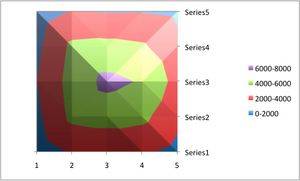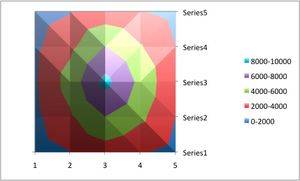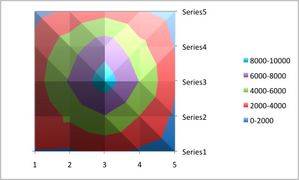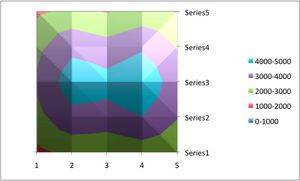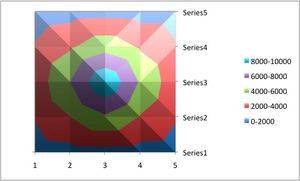You are using an out of date browser. It may not display this or other websites correctly.
You should upgrade or use an alternative browser.
You should upgrade or use an alternative browser.
Air cooled reflector testing with Digital footcandle meter
- Thread starter pico
- Start date
dizzlekush
Member
Doesn't the Radiant 8 have the best results from this data?
dizzlekush
Member
The Radiant 8 has a huge hot spot in the middle, the super sun 2 is more even light.
thanx pico. this is a great thread.
im running 6 600w in Medium Adjust A Wings over an 8'x14.5' grow area... was spreading the w/ft2 thin at 31w/ft2
after reading your thread i think im gonna switch to a 6'x12' grow space and use 8 600w housed in those super sun II's... kick the w/ft2 up to 66.666... more than double what im running ATM.
i know you hate it when people suggest you to test another reflector but im gonna be 100% satisfied when/if you test the Blockbuster. well done. thanks again.
Dizzle -
You may find that your yield per watt decreases with that setup. You will have to play around and see what you like best. I try to spread my lights as far apart as possible so that I can cover as much area as possible, while still getting good bud development in the areas between the two lights. Remember, if you have multiple lights placed together, there is overlapping light between them. So while the numbers in my tests show lower amounts of light out near the edges, if there are other lights equally spaced around it, those numbers will be much higher.
So, if you are not happy with the bud development between lights at 31w/ft2, maybe jump up to 50w/ft2. It all depends on your limiting factor. If you are limited by space, you want to maximize the yield in a given area and you would use a lot of light to make that possible. If you are not limited by space, you want to maximize your yield per watt, and you can use extra space to do so.
For example, typically people use 4'x4' space for 1000w lights. that is 16 square feet. if you bump that area up to 5'x5' that is 25 square feet. That is only an extra 6 inches on each side of the light. Get a reflector with a bit wider spread, raise the light up maybe another few inches.....and you just increased your canopy area by 56.25%. That is a lot of extra room for buds to be growing. and if you have a lot of lights together in a grid you have a lot of overlapping light anyways.
pico
You may find that your yield per watt decreases with that setup. You will have to play around and see what you like best. I try to spread my lights as far apart as possible so that I can cover as much area as possible, while still getting good bud development in the areas between the two lights. Remember, if you have multiple lights placed together, there is overlapping light between them. So while the numbers in my tests show lower amounts of light out near the edges, if there are other lights equally spaced around it, those numbers will be much higher.
So, if you are not happy with the bud development between lights at 31w/ft2, maybe jump up to 50w/ft2. It all depends on your limiting factor. If you are limited by space, you want to maximize the yield in a given area and you would use a lot of light to make that possible. If you are not limited by space, you want to maximize your yield per watt, and you can use extra space to do so.
For example, typically people use 4'x4' space for 1000w lights. that is 16 square feet. if you bump that area up to 5'x5' that is 25 square feet. That is only an extra 6 inches on each side of the light. Get a reflector with a bit wider spread, raise the light up maybe another few inches.....and you just increased your canopy area by 56.25%. That is a lot of extra room for buds to be growing. and if you have a lot of lights together in a grid you have a lot of overlapping light anyways.
pico
dizzlekush
Member
Dizzle -
You may find that your yield per watt decreases with that setup. You will have to play around and see what you like best. I try to spread my lights as far apart as possible so that I can cover as much area as possible, while still getting good bud development in the areas between the two lights. Remember, if you have multiple lights placed together, there is overlapping light between them. So while the numbers in my tests show lower amounts of light out near the edges, if there are other lights equally spaced around it, those numbers will be much higher.
So, if you are not happy with the bud development between lights at 31w/ft2, maybe jump up to 50w/ft2. It all depends on your limiting factor. If you are limited by space, you want to maximize the yield in a given area and you would use a lot of light to make that possible. If you are not limited by space, you want to maximize your yield per watt, and you can use extra space to do so.
For example, typically people use 4'x4' space for 1000w lights. that is 16 square feet. if you bump that area up to 5'x5' that is 25 square feet. That is only an extra 6 inches on each side of the light. Get a reflector with a bit wider spread, raise the light up maybe another few inches.....and you just increased your canopy area by 56.25%. That is a lot of extra room for buds to be growing. and if you have a lot of lights together in a grid you have a lot of overlapping light anyways.
pico
pico thanks for the advice, im extremely fickle at the moment with what im going to change my setup into. first venture into air cooled so im not sure about n e thing, this thread has helped alot. right now im leaning more towards buying Blockbusters and try to cover a 7x14 area (3'6" squares apiece, ^48.98w/ft2
Hey Pico. Would you want to start a new thread and measure MicroMoles
like in this video?
LUMATEK VS MicroMole Ballast Test & Compare Grow Lights Online Hydroponic Store
http://www.youtube.com/watch?v=pGJ50UkxcTg
like in this video?
LUMATEK VS MicroMole Ballast Test & Compare Grow Lights Online Hydroponic Store
http://www.youtube.com/watch?v=pGJ50UkxcTg
it would certainly be a better representation of the number of lamps you have to use. There can be a lot of difference in output between lamps. For the US 1000W US lamps the difference can be up to 20% by choosing a different lamp, 30-35% using a different reflector and lamp and up to 40% with a different lamp, reflector and ballast. So the watts per square meter are not a very accurate way of expressing the required light. Also the use of CO2, climate control and strain choice can influence the amount of light you can have on a square meter, up to 1500 micromoles (though I expect a more optimal yield ratio in normal situations at about 1000 micromoles max).
I agree, you can't simply look at watts per square foot because there are other variables involved. I was using that number as an example since it was referenced in the post. I have no idea how many watts per square foot I am at in my room, I just space them out as needed with the variables in my room. Lumatek 750w ballast, and SS2 reflector, unsure on the bulb.
I would be interested to see the Micromole ballast tested a little further. The test they show is a good start, but they left out a key component. They can't say it is more efficient since they didn't show the input wattage. If it is putting out more light, but taking more electricity, then it isn't any more efficient. It may very well be more efficient, but we don't know from that test. A simple Kill-A-Watt meter would have shown the energy input.
I would be interested to see the Micromole ballast tested a little further. The test they show is a good start, but they left out a key component. They can't say it is more efficient since they didn't show the input wattage. If it is putting out more light, but taking more electricity, then it isn't any more efficient. It may very well be more efficient, but we don't know from that test. A simple Kill-A-Watt meter would have shown the energy input.
1
187020
do certain reflectors work better with organic gardens? which reflector do you recommend for growing Kush?
peace
peace
MicroMole 1000 120-240
Input voltage(V): 120
Nominal Input current(A) at 100% operation: 9.09
Nominal Input current(A) at 115% operation: 10.58
Nominal Input power(W) at 100% operation: 1090
Nominal Input power(W) at 115% operation: 1270
MicroMole 1000 120-240
Input voltage(V): 240
Nominal Input current(A) at 100% operation: 4.42
Nominal Input current(A) at 115% operation: 5.08
Nominal Input power(W) at 100% operation: 1060
Nominal Input power(W) at 115% operation: 1220
Collected a bit of data for you Pico, at 120V it is less efficient than at 240V, where it only dissipates 60W at 1000W and 90W at 120V 1000W. That's pretty cool if you hang it vertical. No need to put a fan on top of that.
If you calculate ballast losses you can see why a 240V ballast will perform better than a 120V. Also you never know if your lamp will actually get 1000W of power if you do not have a HF power analyzer. So you can measure extreme low power use but that doesn't say anything about the output. I will tell you this: If you measure 1050W or less as input on a 240V system, or 1080 or less on a 120V system you are almost certainly not getting 1000W output. So yes, it is difficult to measure and that's why you need to have good reliable source information that is comparable.
Input voltage(V): 120
Nominal Input current(A) at 100% operation: 9.09
Nominal Input current(A) at 115% operation: 10.58
Nominal Input power(W) at 100% operation: 1090
Nominal Input power(W) at 115% operation: 1270
MicroMole 1000 120-240
Input voltage(V): 240
Nominal Input current(A) at 100% operation: 4.42
Nominal Input current(A) at 115% operation: 5.08
Nominal Input power(W) at 100% operation: 1060
Nominal Input power(W) at 115% operation: 1220
Collected a bit of data for you Pico, at 120V it is less efficient than at 240V, where it only dissipates 60W at 1000W and 90W at 120V 1000W. That's pretty cool if you hang it vertical. No need to put a fan on top of that.
If you calculate ballast losses you can see why a 240V ballast will perform better than a 120V. Also you never know if your lamp will actually get 1000W of power if you do not have a HF power analyzer. So you can measure extreme low power use but that doesn't say anything about the output. I will tell you this: If you measure 1050W or less as input on a 240V system, or 1080 or less on a 120V system you are almost certainly not getting 1000W output. So yes, it is difficult to measure and that's why you need to have good reliable source information that is comparable.
Thanks for digging up those numbers. Lumatek lists their 1000w ballast running 100% at 240v at 4.42 amps. Exactly the same as the MicroMole. So if these numbers are true, then the MicroMole would appear to be more efficient, putting out more light for the same input. We are jumping to a couple conclusions here since we are using numbers from different sources and not actually testing the input at the same time as testing output.....but I think this is fairly accurate. If anyone at MicroMole wants to send me a ballast, I will do further testing 
Cravenmore- Neither organic growing, nor kush strains require any special reflector.
Cravenmore- Neither organic growing, nor kush strains require any special reflector.
it basically depends on what they output to the lamp and how much they burn up in heat. If you measure the light and also do the input measurement you can get a pretty good idea. Use a burnt in lamp and let it run for half an hour before doing the light measurement, don't move your lamp and meter during the ballast change. Close the tent during the measurement to rule out external influences.
Rjstoner
Member
if any of you testers get the chance try to test a xxxtreme 6 inch vs Raptor vs block buster (both the raptor and the xxxtreme are bigger than the xxxl)
it would also be great if anyone of you testers could pick up a sun system light spreader
http://www.amazon.com/Hygro-International-SUPER-SPREADER-LARGE/dp/B001IMFIT2
ive got one for all my light but always worried it killed my penetration
thanks for all the research fellas
summary from what i picked up from the thread
ss2 w/ 600w best for 3x3
block buster or mag xxxl with 1000w for 4x4 or bigger (blockbuster for taller plants, xxxL for canopys)
thanks again!!!
it would also be great if anyone of you testers could pick up a sun system light spreader
http://www.amazon.com/Hygro-International-SUPER-SPREADER-LARGE/dp/B001IMFIT2
ive got one for all my light but always worried it killed my penetration
thanks for all the research fellas
summary from what i picked up from the thread
ss2 w/ 600w best for 3x3
block buster or mag xxxl with 1000w for 4x4 or bigger (blockbuster for taller plants, xxxL for canopys)
thanks again!!!
Hey pico, thanks for taking the time to do all of the testing you did - much appreciated information now that I'm shopping for my first hood.
I usually grow vertical, but about to invest in a good hood (all I have is cool tubes) and obviously would like to select one that's ideal for my purposes. In a 3x3 or 4x4 I'd take the SS2 no doubt...
But what about a 6x6? I was shopping for a tent to run a 1000w bulb in, and I believe in covering as much space as you can with a bulb (Tom Hill runs 1kw over 8x8) I know there's no testing but would you be able to make a suggestion on which hood casts a footprint more appropriate for a 6x6 area? I'm just not sure if a larger hood is more beneficial here as I imagine to cover a 6x6 I'd have to hang the SS2 pretty high up. Would a larger hood be able to be hung closer to the canopy?
Edit: After working through the thread backwards, I'm assuming you're going to suggest the Magnum XXXL hood.
I usually grow vertical, but about to invest in a good hood (all I have is cool tubes) and obviously would like to select one that's ideal for my purposes. In a 3x3 or 4x4 I'd take the SS2 no doubt...
But what about a 6x6? I was shopping for a tent to run a 1000w bulb in, and I believe in covering as much space as you can with a bulb (Tom Hill runs 1kw over 8x8) I know there's no testing but would you be able to make a suggestion on which hood casts a footprint more appropriate for a 6x6 area? I'm just not sure if a larger hood is more beneficial here as I imagine to cover a 6x6 I'd have to hang the SS2 pretty high up. Would a larger hood be able to be hung closer to the canopy?
Edit: After working through the thread backwards, I'm assuming you're going to suggest the Magnum XXXL hood.
do certain reflectors work better with organic gardens? which reflector do you recommend for growing Kush?
peace
lmao!!
Dorje113
Member
Great link, thanks! Never saw the Luxor reflectors, they look pretty sweet.
However, a couple points on their testing...
-Adjust a Wings were tested without super spreaders
-Some of the reflectors were designed for an area larger than 4' x 4', so they won't do quite as well as reflectors designed for smaller areas.
-They say the xtrasun wing is the reflector to go with if you don't need air cooled. Unfortunately, they didn't test the unventilated Blockbuster or Magnum (the Agrotech Magnum). Both of these reflectors will, IMO, beat any reflector on that list with the possible exception of the Luxors. You can get block off plates for the vented Magnum hoods, if you're not using the vents that will increase efficiency quite a bit. I just got an Agrotech Magnum for under $100 and IMO, this is the best value hood on the market right now, and should be better than any vented hood you can buy. Although I'd go with the unvented Blockbuster for covering smaller areas (4x4 or smaller).
Also, I don't run vented reflectors anymore, IMO it's not worth it. I have never seen a clean piece of glass under a reflector, even if the air is filtered it gets a white film on the glass. The loss of light is both from the glass and from the compromised reflector, and combined with the hassle and expense of the fan and ductwork, at this point I'd recommend a larger air conditioner instead of vented hoods. In cold weather when you don't need a/c it seems insane to vent the hoods.


